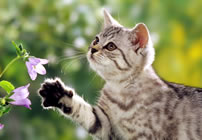 Good, Better, Best… and Watch Out for the Rest!
Good, Better, Best… and Watch Out for the Rest!
The world of cat foods is currently expanding at a mind-boggling speed. While at first this would appear to add to the confusion and overwhelming choices a cat owner is faced with, the beneficial end-result is actually higher quality food production, as well as better options for cats with special needs.
That was then….
There was a time not so long ago when cat foods where simply broken down into the following three groups:
- Canned
- Dry
- Semi-moist
The pros and cons of each were thoroughly debated and often stated, so we won’t go into detail about such things here. Suffice it to say, the choices were generally classified as being good or bad based on their cost, acceptability by cats, nutritional content, and shelf life as well as “bowl life.”
This is now…
The newest cat foods on the market raise the bar for comparison. As more and more people are becoming aware of the long-term consequences of their own food choices, they’re also reconsidering their pet food choices and demanding higher quality products. No longer does the word “meat by-products” go unnoticed or the fact that the main ingredient is corn, no insult intended to the cat foods that contain such items.
New pet “diets” are also on the rise including organic foods only, home-cooked meals, raw food with bones, and vegetarian to name a few of the more popular choices. All of these diets are actually available as pre-packaged meals that save the cat owner the need to obtain the individual ingredients and mix them in a nutritionally balanced manner. To be fair – each of these diets has its proponents as well as its opponents. A non-controversial cat food or feeding regime has yet to be invented!
Foods that have been created for cats with special needs are also becoming more readily available. Such meals exist for cats suffering from allergies, arthritis, dental conditions, diabetes, hairballs, obesity, and urinary tract infections. Age appropriate cat foods for kittens, adults, and seniors are other valuable options, as are foods designed to meet the nutritional needs of breeding cats.
The bottom of the cat food dish…
The bottom line when it comes to what type of cat food to feed your precious fur baby is simple. Feed low cost/low nutritional food and expect the worst. Feed the highest quality food that you can identify as being suitable for your cat, as well as your budget, and you can expect much better results.
As always, do your homework prior to welcoming a new cat into your home. There’s a wealth of information pertaining to cat foods, nutrition, diets, and actual recipes available via the internet, as well as a number of books that have specifically been written about such topics. Because food-selection will potentially have the largest impact on your cat’s overall quality of life, take your time and choose wisely. Cat nutrition is simply not an area to cut costs.
Even though your cat food choices might seem overwhelming, it truly is a good time to own a cat when it comes to food quality and options. It’s better to have too many choices than not enough.

